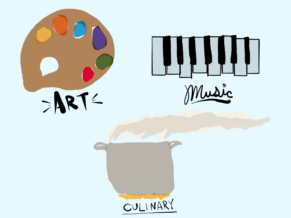Guest post from Michael Cohen, aka @TheTechRabbi
In March, I was fortunate not just to attend, but present at SXSWEdu. I shared the story of my journey from designer to educator, and how my experiences as a designer have influenced my educational practice. One area of education that my past experiences have had the most influence, is creativity. Not just as a vocabulary word, but what creativity is, what it isn't, and what we as educators can do to help our students and colleagues become more creative people.
So in the spirit of creativity, here is a bite-size top 5 list of what educators can learn about creativity from creativity professionals.
-
Creativity Is a Mindset Not a Talent
So what is Creativity? Depending on where you look, you might get 5-6 different definitions ranging from creating something that is original and unique, to something that is artistic or talent driven. It is definitions like these that frustrate me, because they place creativity out of reach for most people by defining creativity as a talent such as art, music, or cooking.
As a designer, I have discovered it’s quite the opposite. Creativity is not a talent, it is a mindset. It is an outlook that allows you to see people, places, and things and how they connect and synthesize with each other. That is because creativity is not about something from nothing, but making something into something more.
So how do we develop this creativity mindset? Practice! Like all of those creative talents, creativity needs to be practiced, and practiced often. To gain some creativity endurance, you can introduce a simple and fun exercise that will challenge you and your students to “stretch their thinking.” One such activity that I challenged SXSWEdu attendees to explore was “How many uses does a Lego wheel have?” The second question I posed was: “Can you come up with 10?”
By looking at creativity as a problem or puzzle-solving process, we can develop a new way of thinking that stretches our mind to think hard, and come up with unconventional ways to utilize commonplace items.
-
Embrace Failure
As a designer, you learn quickly that your first go at anything is NEVER your best. For a designer, F.A.I.L. is more like Fifth, or Fiftieth Attempt In Learning, not First. While teachers might not have the flexibility for the fifth or fiftieth attempt for students to refine work, it is still critical for us to teach our students the concept of failure as not just growth, or a learning experience, but as an actual step in producing high quality work. Think about it, was the iPhone invested on the first try? What about the health and safety of plastic? Students need to see that failure is refinement towards success and not a final conclusion.
-
Empathy is Key
One of the things I learned early on as a designer is to view your client like royalty. That doesn't mean you hold back from sharing your expertise, but it does mean putting the client first. Many designers approach clients as the expert who will create something great for them. For me, this is not design. Design is about taking the vision of a client, mixed with confused and incomplete ideas, and turn them into a clear and crisp message, product, or solution to a challenge they face.
The success behind the above scenario is rooted in empathy. Empathy is a vital ingredient to success when engaging and help others. It's absence is like making bread but hold the flour. So what is empathy anyway? Many tend to define it as understanding our audience, our clients, or students even. Empathy goes beyond that. It’s not just understands them, its understanding them so well that you design experiences that are the best for them and not because you know what's best. This is what empathy’s role in the classroom needs to look like. Are the learning in the best interest of our students? Are they passive recipients of learning or are they the client looking for your to shape their vision and ideas? Are we designing and creating learning experiences for us, for experts, or for them?
-
Technology Is Just A Tool
In college I took a course on typography, which is the style and appearance of printed material. This goes beyond the type of font to choose, but also the spacing between letters, lines of text, and the overall layout of text. As a lover of lettering, I couldn’t wait to start using my Adobe software on my new MacBook to create some awesome typographic designs. My enthusiasm however quickly to a mixture of shock and confusion as we were informed by our professor that no computing technology would be used for the first 8 weeks of the course. Instead we would be using paper, pencil, and pica rulers to hand draw our fonts. I have to be honest, I didn't appreciate it much then, but looking back, I now see that it taught me a life lesson. Computing technology is a tool, just like a pencil. It also taught me how the use of technology needs to be intentional. Efficiency, productivity, and product quality, are only as strong as the intention behind it. We must focus on meaningful learning experiences, and not solely the 21st-century processes that technology can achieve.
-
Collaboration is a Prerequisite for Innovation
Everyone is familiar with the classic group-project scenario. One student does all the work, another takes all the credit, and a third shows up at the end and still gets a good grade. The reason for this is that we generally promote “cooperative” learning experiences in class where the focus is the final product, and not the growth experience that group work promotes. Collaborative learning is a completely different beast. When you look at design firms, or any innovative company, like an Apple or Google, you find that the unique skills of individuals are not just promoted, but celebrated. You would never have a UX Designer trying to manage a project, nor would you find a packaging designer trying to develop a website. In the classroom we need to help students discover and develop their passions and talents and the relationship that those areas can have with the learning experiences they encounter. That is true collaboration and it can make any classroom learning turn into a powerful and relevant learning experience rather than a passive and “pointless” experience for students. Don’t confuse this with fun, but until we begin to value engagement and determination as much as standardized test scores, innovation will take a backseat in the classroom.
For me, this top 5 is meant to spark curiosity, promote self reflection, and help you develop a more creative approach to the challenges you face. I have found that a truly creative mindset is empowering, and gives you the confidence to face your challenges head on.
Rabbi Michael Cohen is an Apple Distinguished Educator and a former Director of Educational Technology. Learn more about Michael at thetechrabbi.com/


